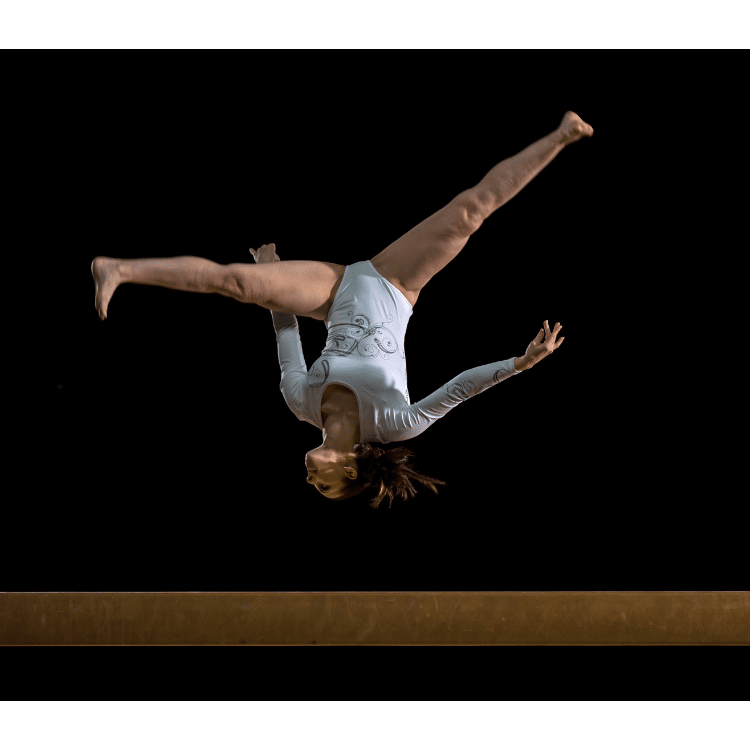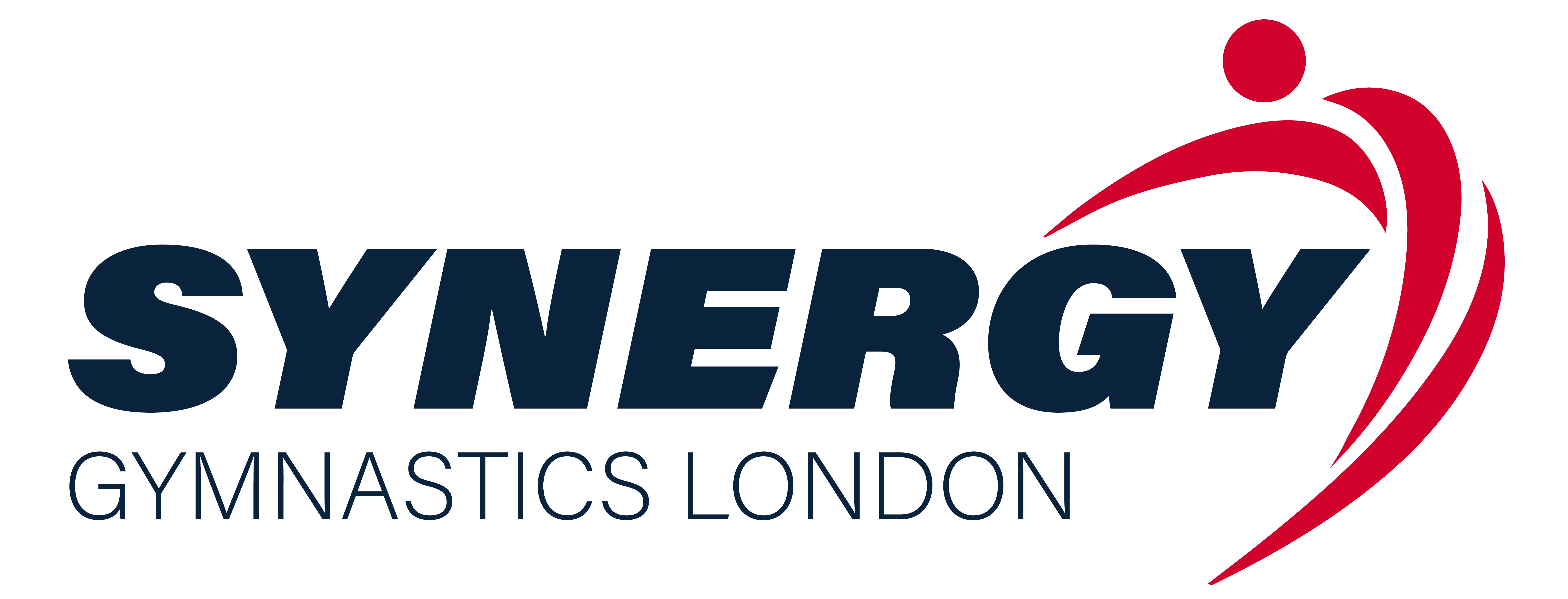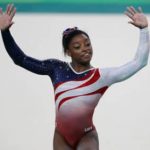Gymnastics is a sport that has a vocabulary of many terms, names and abbreviations which can confuse even those experienced in the sport. In this article, we explain many gymnastics terms and provide links with further information.
Here is a glossary of gymnastics terms in alphabetical order:
10.0 System – The previous scoring system where gymnasts aimed for a perfect score of 10.0 before the change to the open-ended system.
Acrobatic Gymnastics – Acrobatic gymnastics is a discipline where partnerships and groups perform acrobatic skills and lifts in choreographed routines.
Aerial – An acrobatic move in which a gymnast executes a cartwheel without placing the hands on the floor. The Aerial Cartwheel is common in floor routines and on the balance beam.

All-Around Finals – The finals session at big competitions where individual gymnasts compete all four/six events for the All-Around title.
Air Track / Air Mat – An inflatable mat used as a training aid for tumbling skills.
Ankle/Knee Wraps – Bandages used to stabilize joints and prevent injuries during hard landings.
Arabian – A skill in which a gymnast performs a round-off before a front somersault.
Artistry – The Choreography, expressiveness, interpretation of music and stage presence during routines.
Back Handspring – A tumbling skill where the gymnast jumps backward through the handstand shape before snapping their feet down.
Back Tuck – A backward somersault performed in a tucked position in the air.
Back Walkover – A skill in which the gymnast places their hands on the floor, kicks one leg up and back over their body in an arched position and lands upright.
Balk – When a gymnast starts their routine but stops or misses the skill, through fear.
Ball – A rubber ball apparatus thrown, bounced and balanced on the body by rhythmic gymnasts.
Ball Difficulty – Skills like throws, rolls, figures, bounces and catches performed with the ball apparatus.
Bar Routine – A sequence of skills performed on the uneven or high bars during a competition. Women use uneven bars, male gymnasts use the high bar.
Beam Routine – A sequence of skills performed on the balance beam during a competition.
Bent Arms/Legs – Execution errors like bent knees, arms or elbows that incur small deductions from judges.
Biketard – A one-piece garment worn by young gymnasts instead of a leotard. A biketard combines the leotard tank and shorts.

Block – A wedge-shaped foam apparatus used during tumbling and vaulting to elevate the gymnast performing the skill.
Body Position – Proper form during a skill with legs straight and together, head neutral, chest lifted, toes pointed. Judges assess and deduct for body position faults.
Bunheads – A slang term for rhythmic gymnasts who wear sparkly leotards and perform with apparatus.
Cartwheel – A sideways rotating skill where the gymnast supports themselves with their arms while rotating sideways with straight legs.
Cast Handstand – A skill on uneven bars where the gymnast performs a long swing before releasing the low bar to perform a handstand on the high bar.
Chalk – The white magnesium carbonate powder is applied to the hands and feet by gymnasts before routines to remove moisture and increase grip.
Clubs – A pair of wooden batons twirled and handled by rhythmic gymnasts during their routines.
Code of Points – The FIG rules that determine the value of skills and execution deductions for international gymnastics competitions.
Competition Leo – A team leotard worn to represent country or team during major championships.
Compulsory Routines – Pre-determined routines performed at lower levels with specific skills required.
Connection Value – The bonus added to the start score when skills are performed without hops or breaks between elements.
Connections – When skills are performed immediately together without pauses, steps or hops in between. Higher scores are awarded for connections.
Crash Mat – Thick padding placed at the end of the apparatus to cushion the landing on dismounts.
Dance Elements – The choreography, leaps, turns, poses and expressive arm movements performed during floor exercise routines.
Development Program – Lower competitive levels that introduce routines and develop skills before advancing to elite gymnastics.
Difficulty – In gymnastics routines, the difficulty score evaluates the intricacy of individual skills in a routine.
Dismount – The final skill in an uneven bars, high bars, parallel bars, rings or balance beam routine, usually an impressive acrobatic element.
Double Back – A somersault with two full rotations.
Double Mini – A lower, shorter trampoline that gymnasts perform two skills on – one mount skill and one dismount skill. Also know as the DMT.
Elite – The highest level of competitive gymnastics in the US program, divided into junior and senior elite levels.
Event Finals – Held after team and AA finals, where the top gymnasts on each event compete for gold, silver and bronze on that apparatus.
Execution – How well skills are performed. Judges deduct for errors like bent arms/legs, balance checks, lack of height, poor rhythm, incomplete twists, etc.
Extra Swing – An additional forward or backward swing on the uneven bars that exceeds the allowed number.
Federation Internationale de Gymnastique (FIG) – The international governing body for gymnastics that sets the Code of Points rules.
Floor Exercise – An event performed on a 12×12 meter spring floor where gymnasts tumble and dance to music for up to 90 seconds.
Front Handspring – A Front Handspring is a Tumbling skill where the gymnast approaches feet-first and performs a forward flip to land on their feet. A Handspring can also e performed over the Vault.
Front Tuck – A frontward somersault performed in a tucked position in the air.
Giant – A long, continuous circle completed on the horizontal bar or uneven bars above the height of the shoulders.
GK Elite – An American leotard company that outfits many NCAA gymnastics teams.
Grips – Leather wrist supports worn by gymnasts on the uneven bars and rings events to aid gripping.
Grips Bag – A bag or pouch to store grips and prevent rips and chalk dust on other items.
Group Routine – Performed by teams of 5 rhythmic gymnasts who pass, exchange, and manipulate 5 apparatuses between them.
Hair Ties – Ribbons, scrunchies, etc used to tie back long hair so it stays up and out of the face.
Hall of Fame – Located at the National Gymnastics Training Center, it honors previous World and Olympic gymnastics champions.
High Bar – A single horizontal bar, performed on by male gymnasts.
Hoop – A circular plastic apparatus manipulated around the body in rhythmic gymnastics routines.
Horse Vault – The Horse Vault is the old style vault used before the introduction of the table vault in the late 1990s.
Inquiry Review – Using video review, the judges can upgrade scores if an athlete’s federation issues a formal inquiry after the competition.
Invalid Vault – Touching the vault table with only one hand.
Kip – An energetic movement where a gymnast swings backward to generate momentum to lift their hips above the bar into an inverted “candlestick” position.
Landing – The conclusion of a skill where the feet contact the floor. Judges evaluate proper mechanics and control on landing.
Leap – A jump from one foot to the other, with the legs split apart, such as a split or straddle leap. Common on balance beam and floor exercise.
Leg-up Drill – An uneven bar training drill where one leg leads the motion to generate swing.
Leotard – The standard gymnastics competition garment for men and women, a sleeveless unitard.
Line Violation – Crossing outside the borderline on floor exercise merits a deduction.
Longs – Full-length leg coverings worn during training for warmth and protection.
Low Bar – The lower of the two uneven bars.
Mount – The opening skill of a balance beam or uneven bars routine, used to get onto the apparatus.
National Champions – The All-Around winners at the US National Championships held each year in August.
National Team – Elite gymnasts who represent the USA at international competitions like Worlds and Olympics.
Olympic Champions – The All-Around gold medalists from the Olympic Games held every four years.
Out of Bounds – Stepping outside the floor exercise mat earns a deduction.
Pike – A body position where the legs are straight and together and the body is bent in half at the hips. Common position for somersaults.
Pirouette – A full rotation turn on one leg, performed on beam and floor exercise.
Pommel Horse – A men’s apparatus with two pommels or handles affixed over a leather-covered foam body, which gymnasts perform swirling circles and flairs on.
Ribbon – A long satin ribbon attached to a stick that rhythmic gymnasts create swirling patterns with.
Rope – A long rope alternately twisted, coiled and rolled out by rhythmic gymnasts during their routines.
Routine Construction – The composition of skills, order of elements, transitions and artistry of a floor or beam routine.
Routine Elements – Required movements and difficulties like body difficulties, dance steps, apparatus elements and combinations.
Salto – Another name for a somersault performed in a tucked, piked or stretched position.
Scrunchie – A fabric-covered elastic hair tie used to create a bun.
Singlet – The sleeveless leotard worn by male gymnasts during training and competition.
Spotting – A safety technique where coaches assist gymnasts during the learning of new skills to prevent falls and injuries.
Stick – When a gymnast lands a dismount without moving their feet at all to hold the landing position.
Still Rings – A men’s apparatus made of two rings suspended by straps, on which strength and hold skills are performed.
Sting Mat – A thick mat placed under gymnastics apparatus to cushion falls and dismounts during training.
Strength Move – Skills that demonstrate muscular strength like planches, levers, and holds. A key component of men’s gymnastics routines.
Synchro – Synchronized trampoline, where two gymnasts perform the identical routine side by side.
Tariff Sheet – A list of skills and their difficulty values in trampoline used to calculate routine scores.
Team Finals – At major meets, the finals session where countries compete three gymnasts on each event to win the team title.
Tick-Tock – A common uneven bar skill where the gymnast performs a back hip circle (“tick”) directly connected to a front hip circle (“tock”).
Time Limit – The maximum amount of time for a floor or beam routine. Going over earns a deduction.
Time of Flight – How long a trampolinist remains in the air from takeoff to landing during each skill in their passes. Judges look for maximum time of flight.
Toe-on, Toe-off – The foot position during an uneven bars circle element where the toes start on the bar then lift off.
TOPs – Talent Opportunity Program state and national camps that help identify promising young gymnasts.
Tumbling – Acrobatic forward and backward flipping and twisting skills performed on floor exercise.
Tumbling Pass – A continuous run of 8 skills performed along the tumbling track apparatus. Multiple passes make up a tumbling routine. Tumbling is not an Olympic discipline.
Twist – Rotating about the body’s vertical axis during saltos and aerial skills. Skills are named for the number of twists completed.
Two-Per-Country Rule – The limit of two gymnasts per country in apparatus finals, even if they finish top 3 or 8 qualifiers.
Uneven Bars – The women’s apparatus consisting of a high bar and low bar set at different heights where gymnasts perform swinging skills and releases.
Unitard – A one-piece garment worn by gymnasts. The unitard is an alternative to the leotard and combines the shorts and leotard tank.
Vault – An event where gymnasts sprint down a runway towards a vault table and perform an aerial skill off of it onto a landing mat.
Vault Table – The springboard apparatus gymnasts hurdle onto that propels them into the air for vaults.
Wolf Turn – A spin performed on one leg with the other leg held in a high back attitude, named for its creator György Berty. Common on beam and floor.
World Champions – All-Around winners at the World Artistic Gymnastics Championships held annually (except for Olympic years).
Yurchenko – A round-off entry vault named for Soviet gymnast Natalia Yurchenko; the most common vault performed today.
- Why Do Gymnasts Wear Leotards (A Fascinating History)Gymnastics is a sport that has been around for centuries. With its roots tracing back to ancient Greece, gymnastics has come a long way since… Read more: Why Do Gymnasts Wear Leotards (A Fascinating History)
- A Complete Guide on What To Wear To GymnasticsWondering what to wear to gymnastics? We’ve got you covered as your child embarks on their gymnastics journey. In this comprehensive guide, we’ll provide you… Read more: A Complete Guide on What To Wear To Gymnastics
- Self Taught Gymnastics: A Good Idea or Not?Over the last twenty years as a gymnastics coach I have seen a huge increase in the number of children (and numerous adults) that have… Read more: Self Taught Gymnastics: A Good Idea or Not?
- Why Is Gymnastics So Expensive?Why is gymnastics so expensive? It’s a question that echoes through the halls of gyms and the minds of parents when they see the next… Read more: Why Is Gymnastics So Expensive?
- Is Gymnastics Harder Than Football?Many people wonder how hard gymnastics really is compared to other sports. In this article, I will analyze different elements of both gymnastics and football… Read more: Is Gymnastics Harder Than Football?
- Can You Start Gymnastics at 13?Can you start gymnastics at 13? Absolutely, and here’s the kicker – it’s never too late to flip your way into the world of gymnastics.… Read more: Can You Start Gymnastics at 13?






